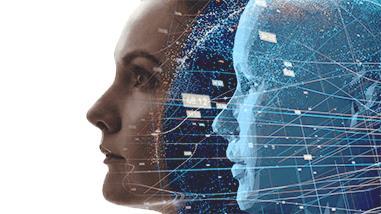Digital twin is the virtual depiction or replica of any physical object or system throughout the lifecycle of it by the inputs from real-time operational data and various sources to bring about better knowledge about the asset for informed decision making. A physical object can vary anything as small as a ball bearing that requires electrical, mechanical and software precision and seamless inter-operation.
Digital twin has moved past the manufacturing sector and has merged with Internet of Things, Artificial Intelligence and data analytics. As more and more complex objects are being connected, the process enables to produce more data to develop a digital replica that further enables scientists and engineers to gather in-depth information to optimize peak efficiency of the object before physically installing it or implementing it by developing scenarios of future possible breakdowns with probable solutions to it.
Digital Twin Application
Mostly used in manufacturing setup, digital twin is quite an advantage in the energy, transportation and construction sectors too. Large and complex objects like aircraft engines, turbines and trains could be digitally designed and tested before being produced. These digital twins are also helpful in maintenance operations, engineers or technicians can seek the digital twin to test before possible fix or upgrade a part of a specific equipment before fixing it on its physical twin.
Creating digital twin with umpteen data requires highly sorted skill sets such as machine learning, AI, predictive analytics and many more science capabilities.
Digital Twin and IoT
With IoT becoming universal, the device sensors used in IoT can be used by digital twin to include small and less complex objects, offering added advantage to companies.
An article by Dave McCarthy cites the reasons of having digital twin to deploy IoT, including the ability of digital twin to foresee various outcomes depending on the variable data. Similar scenario ‘run the simulation’ is often noticed in the Si-Fi movie, where a fictious scenario is depicted within a digital space.
Using added software and data analytics, digital twin can be leveraged to deploy IoT devices for maximum efficiency. In addition, designers can leverage digital twin to ascertain fixing each part into exact device and how to operate before physically deploying. The more a digital twin can replicate a physical object, the higher is the likelihood of replicating the efficiency levels.
According to Dean Hamilton, digital twin and IoT together can revolutionize the manufacturing world. “The more highly instrumented a device is, the more accurately its digital twin will represent its actual historical performance, leading to better analysis and simulation of its future performance,” Hamilton writes.
Problems with Digital Twin
The general approach of digital twin is to demonstrate an insight of the objects or products at operational stage, without highlighting other features or making any comparative study of the product when designed, built and other dynamics of it. It involves a platform creation to line up the characterization of virtual object to translate the complete operational data into the digital twin which enables to comprehensively understand the product performance in comparison to its design intend.
Though digital twin is a virtual image of the product asset in usage in addition to certain predictive analysis and visual elaboration of lifecycle based on predictive algorithm, yet it’s not a complete replacement of ‘inclusive analytics’. Digital twin predictions cannot correlate and map back to product simulation, design modeling and overall lifespan predictive analysis destined at during the design and testing phases. Digital twin can only predict the requirements of parts replacement, it cannot predict a flaw in specific lifecycle of the asset.
Options for Analytics
AI vendors adopt a collective approach of collating and sending all the viable data to create a composite virtual image of a physical object. A virtually created giant asset such as a car has the capability of sending 25GB or more data per hour back to the cloud. The need is creation of algorithm analytics for running the data that is constantly created at the edge of the enterprise network. Analytics or cognitive automation is a mandate to recognize and deliver data to the cloud pro-actively before the networks hit a complete gridlock, that Immersive Analytics vendors often fail to acknowledge nor address.
Digital twins can greatly augment an enterprise’s ability to make proactive, data-driven decisions, enhancing efficiency and evading potential problems. However, it can be a huge challenge for companies to create a digital twin if they would like to try this all at once. Best option is to start in one area, deliver value and continue to develop.
Reference
https://www.zdnet.com/article/the-rise-of-the-digital-twin-why-the-enterprise-needs-to-take-notice/
https://www2.deloitte.com/content/dam/Deloitte/cn/Documents/cip/deloitte-cn-cip-industry-4-0-digital-twin-technology-en-171215.pdf
https://internetofbusiness.com/half-of-businesses-with-iot-projects-planning-to-use-digita-twin/
